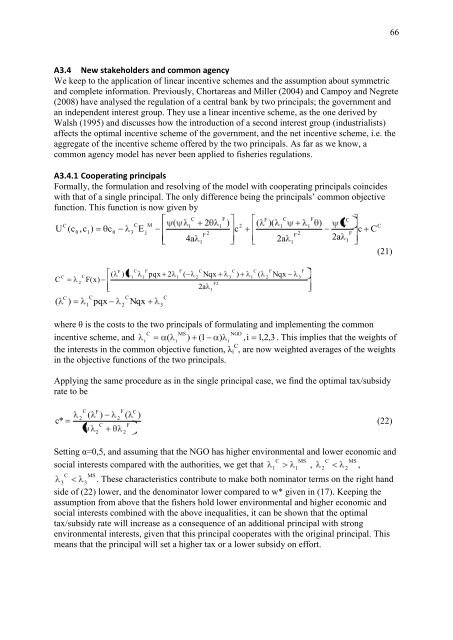Operational tools and adaptive management
Operational tools and adaptive management
Operational tools and adaptive management
Create successful ePaper yourself
Turn your PDF publications into a flip-book with our unique Google optimized e-Paper software.
A3.4 New stakeholders <strong>and</strong> common agency<br />
We keep to the application of linear incentive schemes <strong>and</strong> the assumption about symmetric<br />
<strong>and</strong> complete information. Previously, Chortareas <strong>and</strong> Miller (2004) <strong>and</strong> Campoy <strong>and</strong> Negrete<br />
(2008) have analysed the regulation of a central bank by two principals; the government <strong>and</strong><br />
an independent interest group. They use a linear incentive scheme, as the one derived by<br />
Walsh (1995) <strong>and</strong> discusses how the introduction of a second interest group (industrialists)<br />
affects the optimal incentive scheme of the government, <strong>and</strong> the net incentive scheme, i.e. the<br />
aggregate of the incentive scheme offered by the two principals. As far as we know, a<br />
common agency model has never been applied to fisheries regulations.<br />
A3.4.1 Cooperating principals<br />
Formally, the formulation <strong>and</strong> resolving of the model with cooperating principals coincides<br />
with that of a single principal. The only difference being the principals‟ common objective<br />
function. This function is now given by<br />
U<br />
C<br />
(<br />
C<br />
C<br />
C<br />
( c , c )<br />
)<br />
0<br />
C<br />
2<br />
1<br />
F<br />
( x)<br />
C<br />
1<br />
pqx<br />
c<br />
(<br />
0<br />
F<br />
)<br />
C<br />
2<br />
C<br />
3<br />
C<br />
1<br />
E<br />
M<br />
j<br />
F<br />
1<br />
Nqx<br />
pqx<br />
C<br />
3<br />
2<br />
(<br />
F<br />
1<br />
C<br />
1<br />
4a<br />
(<br />
C<br />
2<br />
2<br />
2<br />
F<br />
1<br />
2a<br />
Nqx<br />
F2<br />
1<br />
F<br />
1<br />
where θ is the costs to the two principals of formulating <strong>and</strong> implementing the common<br />
C<br />
MS<br />
NGO<br />
incentive scheme, <strong>and</strong> i ( i ) ( 1 ) i , i 1,<br />
2,<br />
3 . This implies that the weights of<br />
the interests in the common objective function, λi C , are now weighted averages of the weights<br />
in the objective functions of the two principals.<br />
Applying the same procedure as in the single principal case, we find the optimal tax/subsidy<br />
rate to be<br />
C<br />
2<br />
C<br />
2<br />
F C<br />
2 (<br />
F<br />
2<br />
F<br />
( ) )<br />
c *<br />
(22)<br />
Setting α=0,5, <strong>and</strong> assuming that the NGO has higher environmental <strong>and</strong> lower economic <strong>and</strong><br />
social interests compared with the authorities, we get that<br />
C MS<br />
,<br />
C<br />
3<br />
MS<br />
3<br />
)<br />
C<br />
3<br />
c<br />
)<br />
2<br />
C<br />
1<br />
(<br />
(<br />
F<br />
)(<br />
F<br />
2<br />
C<br />
1<br />
2a<br />
Nqx<br />
2<br />
F<br />
1<br />
F<br />
3<br />
F<br />
1<br />
1 1 ,<br />
)<br />
C<br />
2<br />
2a<br />
C<br />
F<br />
1<br />
MS<br />
2<br />
c<br />
C<br />
C<br />
(21)<br />
. These characteristics contribute to make both nominator terms on the right h<strong>and</strong><br />
side of (22) lower, <strong>and</strong> the denominator lower compared to w* given in (17). Keeping the<br />
assumption from above that the fishers hold lower environmental <strong>and</strong> higher economic <strong>and</strong><br />
social interests combined with the above inequalities, it can be shown that the optimal<br />
tax/subsidy rate will increase as a consequence of an additional principal with strong<br />
environmental interests, given that this principal cooperates with the original principal. This<br />
means that the principal will set a higher tax or a lower subsidy on effort.<br />
66

















